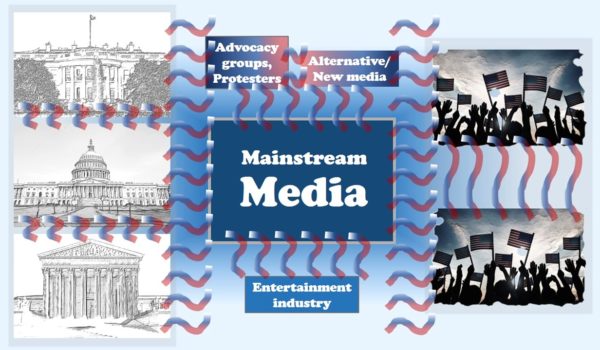
It looks like the UC-Santa Barbara killer, Elliot Rodger, did manage to rack up the highest body count. With himself included, he killed seven people in a rampage on Friday, 23 May, as the Memorial Day weekend began (see LU’s coverage here and here).
But an argument can be made that Rodger’s rampage was no more disruptive to the community as a whole than the three murders, five shootings, and seven injuries in Myrtle Beach, South Carolina over the holiday weekend, all of which were linked to a biker rally.
No fatalities, meanwhile, are reported to have come from what turned into a near-riot in Fort Lauderdale, Florida on Monday. (See here as well. There was one stabbing; the victim apparently is recovering and declined to cooperate with police or press charges.) But the beach community there was for hours the scene of a heavily armed lockdown, as police and the Broward County Sheriff sought to disperse a crowd of hundreds of “young people” who had reportedly gathered on the beach to fight. Balked by the police of their fighting venue, the “young people” began attacking drivers of vehicles on the A1A, and jumping on top of taxicabs.
Will this presidential election be the most important in American history?
Five or six years ago, Americans were making fun of the custom among “French youths” of torching cars on New Year’s Eve. The practice involved recent immigrants from North Africa, all Arabs and black Africans, and all Muslims. The French media and government authorities ignored that reality, however, always careful to speak as if it might be the scions of Ludovic and the langue d’oeil setting cars on fire around France’s grandes villes.
The outline of this type of weird wilding has been slowly emerging on American shores over the last couple of decades. Certainly, the U.S. has had riots and civic mayhem from time to time for many years. But such incidents have been occasional and rarely predictable – only sometimes linked to anticipated events, like big wins or losses in the NBA finals.
Now, however, the American pattern is developing like the French “tradition,” in connection with specific vacation holidays and in predictable places: high-profile beach communities, mostly on the East coast. Not all such incidents are connected to big holiday weeks (or weekends) at the beaches; see, for example, Renee Nal’s summary of the eruptions by “young people” that closed the Florida state fair in Tampa in February of this year. But a pattern is emerging.
Mayhem on the Q.T.
You may have heard very little about it though. You might not be aware, for example, of the modern tradition of destruction and mayhem connected with “Beach Week” or “Beachfest” on the Virginia Beach boardwalk in southern Virginia. The first time the event turned into a full-blown riot was in 1989, when it was billed as “Greekfest” (because attendees were almost all from the fraternities at black colleges in the region), and held the week before Labor Day. Organizers moved it in the years since to late April.
Equally treacherous has been the event called “Black Bike Week,” a biker rally held in the Myrtle Beach area each year in the week after “Harley Week” (the latter also billed as “Bike Week,” a biker rally without a racial hook). Conservative Treehouse points out that it’s the organizers who call it “Black Bike Week” and stress the racial aspect. Black Bike Week was the scene of multiple shootings and homicides (mentioned above) over 2014’s Memorial Day weekend. As with Virginia Beach, in most years the Myrtle Beach Black Bike Week sees vandalism, theft, damage to local businesses, public misbehavior, and arrests.
Florida’s beaches, meanwhile, have been the sites of a number of disturbances over the years, both with and without a racial component. Florida is a particularly interesting case, in fact, because its recent history serves as a sort of nexus illustrating the peculiar dynamic in these sometimes fatal beach wildings: that of the federal government and the NAACP jumping in, on principle, on the side of disorder and mayhem.
Federal-government and activist support for disorder
On Monday evening, 26 May, a large crowd of black “young people” converged on a beach in Fort Lauderdale, in order – according to police – to launch a big fight. As described earlier, the surge of young people produced a stabbing, but police were all over the area and broke up the crowd. The frustrated crowd then flooded the A1A – the highway-boulevard that runs down Florida’s Atlantic coast boardwalks – and began attacking vehicles. It took police and sheriff’s forces hours to clear the area and restore order.
It’s not to suggest that there is a cause-and-effect relationship here that I point out the following. It is, rather, to highlight the very different reaction of the self-appointed advocates of “equal opportunity” to this kind of mayhem, versus the mayhem perpetrated by Elliot Rodger on 23 May.
Florida, of course, is where George Zimmerman shot Trayvon Martin on an awful night in February 2012. And it was in Florida that the U.S. Department of Justice sent federal employees, on the taxpayer’s dime, to facilitate street protests in the months afterward (see here and here as well). Justice Department sponsorship was involved not only in arranging a police escort for protesters, but in barricading the Sanford, Florida police department.
As I noted last year (link in previous paragraph), inserting federal agencies into the agitation process, and claiming that there must be “mediation” between the community authorities and the disgruntled/disorderly, creates an extra-legal negotiating space in which shakedowns and extortion become likely. And lo and behold: in a fascinating and interrelated development, that’s exactly what’s been happening in Myrtle Beach.
A decade ago, merchants and restaurateurs were closing their doors for Black Bike Week because of the likelihood of damage and theft. The NAACP is having none of that, however; they demand that businesses stay open, regardless of the cost to the businesses, and they want Black Bike Week-goers to report to the NAACP when they see businesses closed during the week. The federal court system and U.S. law backstop this campaign of extortion. Here’s the NAACP in a news release cited by Conservative Treehouse:
In 2006, the NAACP successfully concluded every federal discrimination lawsuit filed in Myrtle Beach that arose from complaints by African American tourists who attended Black Bike Week festivities between 1999 and 2003. The lawsuits referenced unequal treatment of black motorcyclists by the city, four restaurants and a hotel.
Negotiated settlements were reached with the City of Myrtle Beach, Damon’s Oceanfront and Barefoot Landing, Greg Norman’s Australian Grill, the Yachtsman Resort Hotel and J. Edward’s Great Ribs and More.
Let’s recap the point: the NAACP lawsuits were to force businesses to remain open during Black Bike Week, on pain, presumably, of additional lawsuits and extortionate monetary settlements. Regardless of other circumstances, the businesses would be subject to the shakedown.
In this context, it seems only predictable that after the 1989 riot in Virginia Beach, the U.S. Justice Department opened an investigation of the city for alleged discriminatory treatment of rioters. (The Greekfest riot, which lasted for nearly two days, resulted in charges against more than 1,200 people and property damage in excess of $1.4 million.)
Of course, we don’t have to go as far as the East coast to find different reactions – by the media and authorities – to mayhem and/or murder events.
Conservative Treehouse highlights the counterpoint in 2014 between the intense media scrutiny of the Elliot Rodger killings in California and the near-black-out of the homicidal mayhem caused during Black Biker Week in Myrtle Beach, even though the latter directly affected more of the local community. To find a mayhem event that got the same kind of coverage as the Elliot Rodger killings, we can go just a short hop in miles from Santa Barbara (or Isla Vista), and 22 years back in time, to the Los Angeles riots of 1992, after the Rodney King verdict.
By the Los Angeles Times’ count, there were 63 people killed in the violence in 1992 (many of them by gunshot). The city was paralyzed for days and the National Guard had to be deployed to restore order.
Sensing a double standard here requires no more than average alertness. Such a double standard is a great insult to the majority of black Americans who hold themselves to a high standard of behavior and have nothing to do with mayhem or shakedowns. In undermining the rule of law and the public character, the double standard is especially pernicious.




